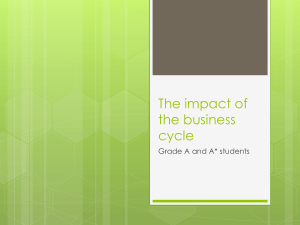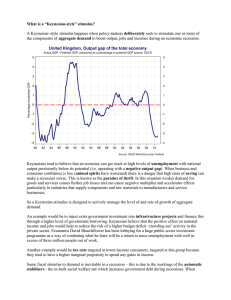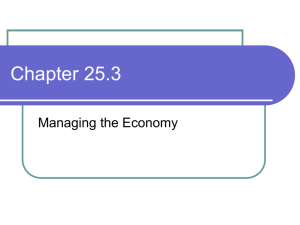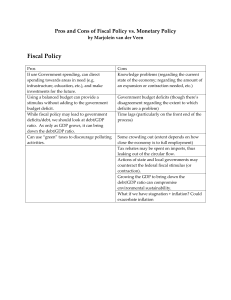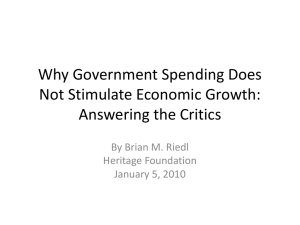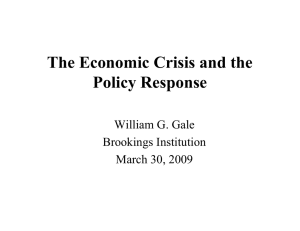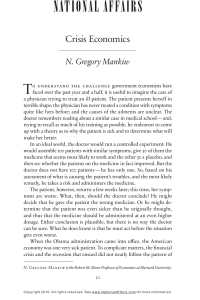Rebalancing the world economy: America
advertisement
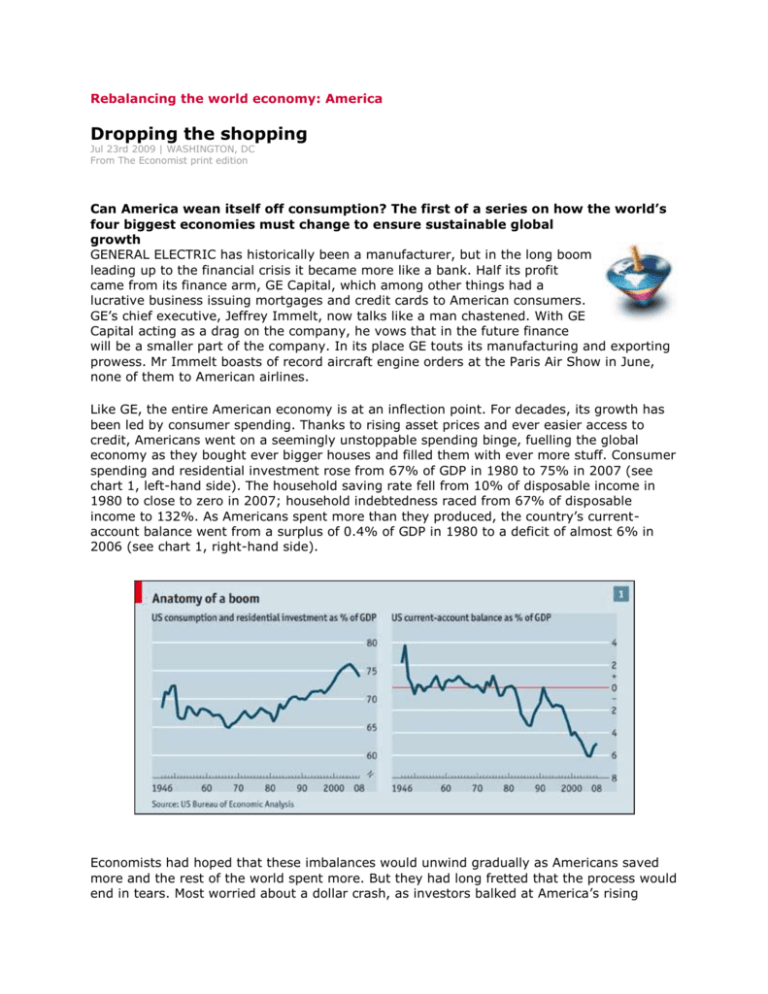
Rebalancing the world economy: America Dropping the shopping Jul 23rd 2009 | WASHINGTON, DC From The Economist print edition Can America wean itself off consumption? The first of a series on how the world’s four biggest economies must change to ensure sustainable global growth GENERAL ELECTRIC has historically been a manufacturer, but in the long boom leading up to the financial crisis it became more like a bank. Half its profit came from its finance arm, GE Capital, which among other things had a lucrative business issuing mortgages and credit cards to American consumers. GE’s chief executive, Jeffrey Immelt, now talks like a man chastened. With GE Capital acting as a drag on the company, he vows that in the future finance will be a smaller part of the company. In its place GE touts its manufacturing and exporting prowess. Mr Immelt boasts of record aircraft engine orders at the Paris Air Show in June, none of them to American airlines. Like GE, the entire American economy is at an inflection point. For decades, its growth has been led by consumer spending. Thanks to rising asset prices and ever easier access to credit, Americans went on a seemingly unstoppable spending binge, fuelling the global economy as they bought ever bigger houses and filled them with ever more stuff. Consumer spending and residential investment rose from 67% of GDP in 1980 to 75% in 2007 (see chart 1, left-hand side). The household saving rate fell from 10% of disposable income in 1980 to close to zero in 2007; household indebtedness raced from 67% of disposable income to 132%. As Americans spent more than they produced, the country’s currentaccount balance went from a surplus of 0.4% of GDP in 1980 to a deficit of almost 6% in 2006 (see chart 1, right-hand side). Economists had hoped that these imbalances would unwind gradually as Americans saved more and the rest of the world spent more. But they had long fretted that the process would end in tears. Most worried about a dollar crash, as investors balked at America’s rising foreign borrowing. Instead the financial crisis felled America’s consumers. The destruction of more than $13 trillion of consumer wealth and the implosion of the shadow banking system, a once plentiful source of credit, has triggered a shift to thrift, which in turn has plunged the economy into its deepest recession in decades. Americans now save more than 5% of their after-tax income, still well below the post-war average but hugely up from only a year ago. The current-account deficit has shrunk dramatically: the IMF projects that it will shrivel to less than 3% of GDP this year and next as Americans spend and invest less. The collapse in consumption has dramatically changed the composition of America’s economy. A huge increase in private saving has been offset by a leap in the budget deficit. The combination of Barack Obama’s big fiscal stimulus package, as well as the natural consequence of declining tax revenues, means that the federal budget deficit this year is likely to be 13% of GDP, about 12 percentage points more than in 2007. That has cushioned the slump. GE is among those taking advantage. It is aggressively pursuing stimulus-related sales, while tapping federal, state and local incentives. In June the company said that it would create 400 jobs at a plant in Louisville, Kentucky, making a low-energy water heater that is now made in China and that it would hire 1,100 people to staff a software research centre on the site of an auto plant in Van Buren, Michigan. Both investments were helped along by government incentives. Getty Images But despite the government’s largesse, America’s recession has been deep and its impact on the rest of the world profound. Though America is still a source of demand for the rest of the world, its waning appetite has been a hefty drag on world economic growth. In the years before the financial crisis kicked in, American demand contributed to global growth. This year it will subtract from it. As the boost from fiscal stimulus takes effect there are signs that America’s economy is stabilising. An index of leading indicators compiled by the Conference Board, a research group, rose for the third consecutive month in June. In testimony to Congress on July 21st, Ben Bernanke, the chairman of the Federal Reserve, struck an undeniably upbeat tone about the state of the economy. But the bigger issue—for America and for the world—is where growth will come from in the medium term. The answer is not entirely in America’s hands—in the coming weeks, our series will also look at whether the world’s big surplus economies, China, Germany and Japan, will boost their domestic demand. But as the world’s biggest economy America is the right place to start. Three questions stand out. Can America continue to rely on government stimulus to drive growth? Will the consumer recover? Or can exports take up the slack? The answer to the first question is “not for ever”. In the short term, policymakers are committed to using a mixture of fiscal stimulus and aggressive monetary policy to hasten the end of the recession and prevent inflation from turning into deflation. But the contribution of the stimulus is due to start ebbing in 2010. The lesson of Japan in the 1990s is that the after-effects of a bubble suppress demand for longer than most expect, necessitating extended government stimulus. Unlike Japan, though, America is already in hock to the foreigners. Mohamed El-Erian of Pimco, a fund manager, predicts that policymakers will be reluctant to stimulate any further for fear of feeding suspicions that America will inflate away its debts, which could push long-term interest rates much higher. Even if they do not withdraw the stimulus next year, they must at some point if the federal debt, projected to double to 82% of GDP by 2019, is to stop rising. The prospect of a withdrawal of government support need not spell disaster. As America looked forward to the end of the second world war, policymakers were deeply anxious that as war spending shrank, the economy would slip back into 1930s-like stagnation. “All alike expect and fear a post-war collapse,” Alvin Hansen of Harvard University, a leading economist of the time, wrote in 1942. Yet the collapse never came. Thanks to rising productivity and rapid recovery in Europe and Japan, the post-war years witnessed strong, balanced growth. From 1946 until 1980, American households saved 8-10% of their disposable income and the country usually ran small trade surpluses. An historic challenge Perhaps productivity can accelerate again, boosting incomes enough to support robust spending as well as more saving. But an obvious difference from the post-war period is the need for American consumers to reduce their debts. Richard Berner of Morgan Stanley notes that in the past decade the proportion of income that American households devoted to servicing debt rose from 12% to 14%. He calculates that it would have risen to only around 12.5% but for a dramatic loosening of lending standards during the recent bubble. He thinks the ratio will revert to around 12% through a combination of lower interest rates, debt repayments and write-offs. That can be done, he says, with consumer spending growing at just over 2% a year, still far below its average of 3.4% from 1993 to 2007. The implication is that demand from abroad must take the place of a splurging domestic consumer and a free-spending government. As Larry Summers, Mr Obama’s chief economic adviser, said on July 17th: “The rebuilt American economy must be more export-oriented and less consumption-oriented.” Take California, where the consumption and housing bubbles were especially pronounced. The shortage of land on the coasts drove many first-time homebuyers inland, fuelling a huge building boom. According to Jerry Nickelsburg of the Anderson Forecast at the University of California, Los Angeles, home-building permits tripled between the 1990s and 2005. The growth of new housing developments triggered a boom in new retail stores, lured by local government incentives. Meanwhile, America’s ravenous appetite for imports from Asia fuelled business at the ports of Long Beach, Los Angeles and Oakland and their supporting infrastructure of railroads, transport and warehouses. California’s disproportionate exposure to the boom explains why its bust has been especially painful. Mr Nickelsburg says home-building permits have plunged by 85% since 2005 and that the value of new retail-construction permits has fallen by half. Import volumes have dropped sharply. Most big subprime lenders have gone bankrupt or left the business. The first glimmers of an export-led revival are apparent. The state’s manufacturing employment has shrunk by less than in most of the big manufacturing states, reflecting less dependence on carmakers and greater exposure to Asia. The seasonally adjusted number of containers loaded at its ports for export, many with agricultural products and other raw materials, has risen from the lows of earlier this year. But it is one thing for exports to grow (and imports to fall) but another entirely for trade to compensate for the retrenchment of the much larger consumer sector. A cheaper currency may help. The trade deficit narrowed sharply in the late 1980s with the help of a dramatic fall in the dollar against the currencies of America’s largest trading partners. The dollar has come down considerably since 2002 but has rallied over the past 12 months as investors have repatriated money from abroad. Its decline is likely to resume but its contribution to rebalanced growth will be constrained if China does not let the yuan appreciate against the dollar. Turning circle Nor is it clear how quickly America can shift resources into tradable products. Its economy is adept at moving workers and capital from dying to growing industries. But the scale of the adaptation needed now is daunting. Robert DiClemente, an economist at Citigroup, estimates that creditsensitive industries—housing, finance and cars— have shed 2m jobs, or one-third of all those lost, since the recession began (see chart 2). It is not clear how quickly mortgage brokers and structuredfinance whizzes can retrain in more productive industries. The fact that so many homeowners are sunk in negative equity will also constrain mobility. The American economy is like a supertanker that, even in calm waters, changes direction very slowly. It is now being forced to do so in a gale. With the help of still sturdy growth in emerging markets America should be able to reorient itself. But come what may, changing direction means losing speed. On the demand side foreign spending is unlikely to compensate for the freewheeling American consumer. On the supply side investment has slumped and will take time to right its course. Pimco’s Mr El-Erian reckons that the transition from consumption to export-oriented expansion will lead to prolonged subpar growth and high unemployment. That will heighten political risks such as protectionism. The House of Representatives, for example, has passed a bill aimed at capping American carbon emissions that would slap tariffs on countries that do not do likewise. The steelworkers’ union has attacked Mr Immelt as a hypocrite for touting GE’s new focus on manufacturing while opposing “Buy American” provisions in the stimulus package. Mr Obama’s support for free trade remains lukewarm, a failing that could yet undermine hopes for export-led growth. Writing America off is always a dangerous thing to do. Most probably, however, it faces years of painfully high unemployment and sluggish growth. GE’s union at its plant in Louisville had to agree to a wage freeze until 2011 and to let new employees start for just $13 an hour. Like GE’s workers, Americans will find the new, export-driven model of growth much less comfortable than the old one.
